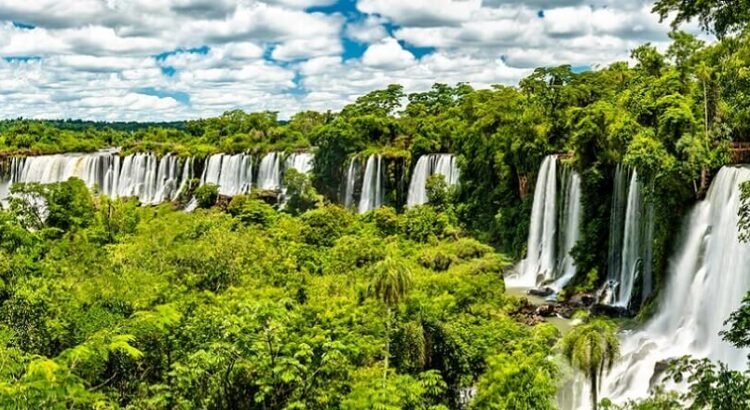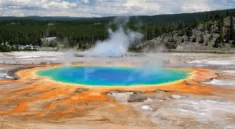
Nestled between the borders of Argentina and Brazil, Iguazu Falls is a place where nature displays its rawest power and most delicate beauty in perfect harmony. This colossal system of over 275 individual waterfalls spread across a nearly 3-kilometer stretch of the Iguazu River is considered by many to be the most breathtaking waterfall complex in the world. More than just a geographical wonder, Iguazu is a multi-sensory experience—the roar of crashing water, the mist that clings to your skin, the rainbows arching through the clouds, and the lush rainforest teeming with life.
Declared a UNESCO World Heritage Site, and often ranking among the New Seven Natural Wonders of the World, Iguazu Falls is not merely visited—it is felt, it is heard, and it is remembered forever. Whether you approach it from the Argentine side with its immersive walkways and close encounters or from the Brazilian side with panoramic viewpoints, the grandeur of Iguazu is utterly unforgettable.
A Natural Marvel Born of Fire and Water
The Iguazu Falls were formed around 135 million years ago, the result of volcanic activity and the shifting of tectonic plates. The basalt rock formations that make up the landscape tell a geological story of upheaval, lava, and erosion, sculpted over eons into the mighty cascades we see today. The river itself, the Iguazu, flows gently until it reaches a dramatic drop—sending torrents of water plunging over cliffs in a spectacular display of natural force.
The most famous section of the falls, the Garganta del Diablo, or Devil’s Throat, is a U-shaped chasm 82 meters high and 150 meters wide where water crashes down in a deafening crescendo. Standing at the viewing platform, enveloped in spray and thunder, one can feel the awe and humility that nature inspires. It is both exhilarating and humbling, a reminder of the planet’s grandeur.
Two Countries, Two Perspectives
What makes Iguazu Falls truly unique is the fact that it spans two nations, each offering distinct experiences:
The Argentine Side – Immersive and Adventurous
Argentina provides the intimate, up-close experience. Located within Parque Nacional Iguazú, the Argentine side offers a series of catwalks and walkways that take visitors through the heart of the waterfall system.
- The Upper Circuit provides stunning views from above the falls, where you can appreciate the sheer volume and velocity of water.
- The Lower Circuit allows visitors to get incredibly close to the falls, where you can feel the spray on your face and the thunder in your chest.
- The Devil’s Throat trail, accessible by a scenic ecological train ride, leads to the most dramatic and awe-inspiring viewpoint—a platform that seems to hover above the chasm.
Argentina’s approach to the falls is immersive, visceral, and deeply connected to the surrounding rainforest. It’s perfect for adventure seekers, photographers, and those who want to feel the falls with all their senses.
The Brazilian Side – Panoramic and Majestic
On the Brazilian side, within Parque Nacional do Iguaçu, the experience is more about the bigger picture. The walkways here offer sweeping panoramic views of the entire system, making it ideal for those who want to capture the falls’ full grandeur in one breathtaking scene.
- The main trail takes you down to a catwalk that juts into the middle of the river, providing a dramatic frontal view of the Devil’s Throat.
- An elevator brings visitors up to a higher platform for a bird’s-eye view of the cascading falls and the lush jungle beyond.
- The vistas here are perfect for landscape photography and contemplation, offering a majestic sense of scale.
Together, the two sides offer a complete Iguazu experience—one intimate and wild, the other grand and majestic. Most travelers opt to visit both, as neither side alone captures the full splendor of Iguazu Falls.
A Living Ecosystem: The Lush Rainforest of Iguazu
Iguazu is not just about the waterfalls. The surrounding rainforest is a biological treasure trove, home to one of the most diverse ecosystems in South America. Encompassed by subtropical jungle, both national parks harbor thousands of plant and animal species, many of which are endangered or found nowhere else on Earth.
Among the fauna you might encounter:
- Coatis: curious raccoon-like mammals often seen near trails.
- Toucans and parrots: their vibrant colors and songs enrich the jungle.
- Jaguars and pumas: elusive and protected apex predators.
- Butterflies: countless species dance through the mist.
- Monkeys: often seen swinging in the treetops.
Botanically, the forest bursts with ferns, orchids, towering trees, and exotic flowering plants, all thriving in the misty, humid climate created by the falls. The conservation efforts in both countries ensure that this delicate, rich habitat remains protected for generations to come.
Adventures and Activities Beyond the Viewpoints
For those who crave adventure, Iguazu delivers thrilling experiences:
- Boat rides: Get soaked as you speed toward the base of the falls in a rigid inflatable boat. These adrenaline-pumping rides take you right under some of the smaller cascades.
- Helicopter tours: From the Brazilian side, these flights offer an unforgettable aerial view of the falls, showcasing the immensity of the system in a way no ground view can.
- Jungle safaris: Take guided 4×4 or walking tours through the jungle to spot wildlife, learn about flora and fauna, and explore hidden corners of the park.
- Kayaking and rafting: In calmer parts of the river, these activities let you explore the serene side of Iguazu.
Whether you want to feel the power of the falls up close or explore the pristine wilderness, Iguazu offers a diverse range of experiences for all types of travelers.
Best Time to Visit: When the Water Roars Loudest
Iguazu Falls is a year-round destination, but your experience can vary depending on the season:
- Summer (December to March): Hot and humid, but the falls are usually at their most powerful due to higher rainfall. Be prepared for intense sun and crowds.
- Winter (June to August): Cooler and less humid, making it more comfortable for hiking and exploration. Water flow can be lower but still spectacular.
- Shoulder seasons (April-May and September-October): Generally the best time—fewer crowds, good water levels, and milder weather.
Regardless of the season, the sheer volume of water, the surrounding rainforest, and the immersive atmosphere make any time a good time to visit.
Cultural Significance and Mythology
According to Guarani legend, the falls were created when a deity, enraged by a mortal woman fleeing with her lover in a canoe, split the river and created the waterfalls to trap them forever. This myth adds a layer of spiritual and emotional depth to the already dramatic natural wonder.
For locals in both Argentina and Brazil, the falls are a source of pride, not just as a tourist attraction but as a sacred natural site that embodies the spirit of the land.
Practical Tips for Travelers
- Entry Requirements: Each side of the falls is managed by separate national parks. You’ll need tickets for both if you plan to cross the border.
- Visas and crossings: Travelers should check visa requirements for Brazil and Argentina, especially if planning to visit both sides.
- Accessibility: Both parks have paths and facilities suitable for wheelchair users, though some trails may be steep or uneven.
- Stay nearby: Consider hotels in Puerto Iguazú (Argentina) or Foz do Iguaçu (Brazil) for easy access. There are also eco-lodges within the parks for a unique experience.
- Pack for the falls: Waterproof bags, ponchos, comfortable shoes, sunscreen, and insect repellent are essential.
A Journey Beyond Words
Words can only do so much to describe the thunder, the mist, the rainbows, the scale, and the emotion that Iguazu Falls evokes. Standing before it, you don’t just see or hear nature—you feel it surge through you.
Iguazu is a place where opposites collide: power and peace, noise and silence, chaos and harmony. Whether you’re standing at the brink of Devil’s Throat with water roaring around you or quietly watching butterflies flutter above a jungle trail, the experience leaves a permanent mark on your soul.
It is no wonder that even Eleanor Roosevelt, upon witnessing Iguazu, reportedly exclaimed, “Poor Niagara!”
Conclusion: A Once-in-a-Lifetime Experience
Iguazu Falls is not just a waterfall—it’s an epic, multi-sensory encounter with nature’s might and beauty. It is a place where rivers leap from cliffs, where two countries meet in awe, and where travelers from across the world come to be humbled and inspired.
Whether you come for the views, the adventure, the photography, or the soul-stirring presence of nature in its most majestic form, one thing is certain:
You will leave Iguazu Falls changed.




